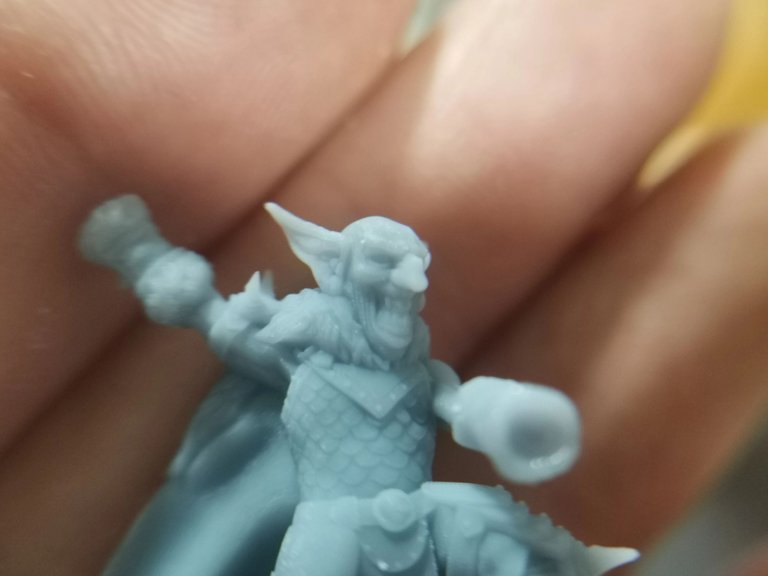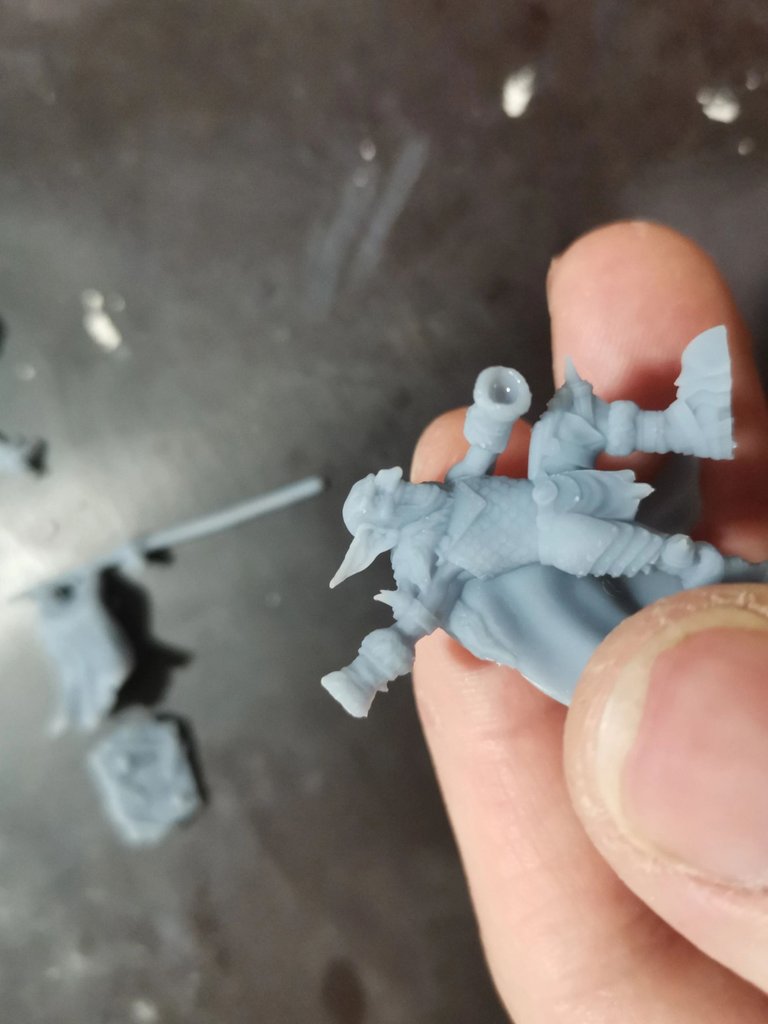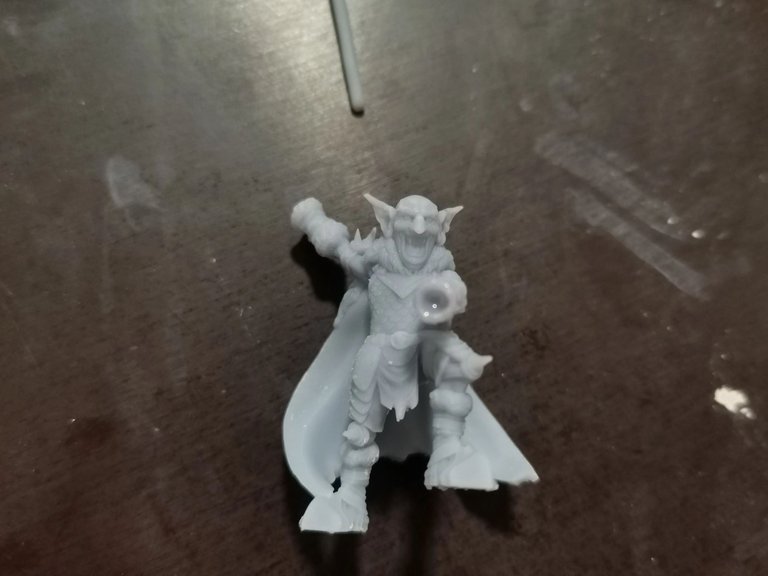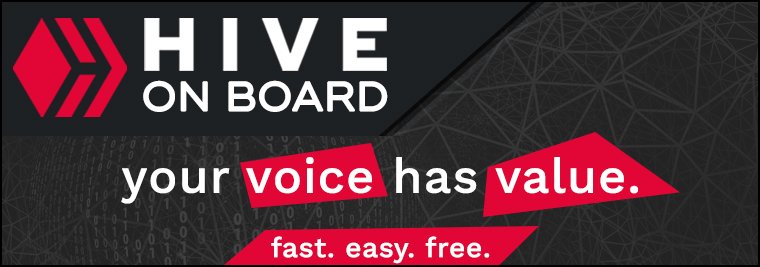DEU
In den letzten paar Tagen habe ich mich intensiver mit Stützstrukturen befasst und diese einmal selber an meine Miniaturen angebracht, um ein besseres Verständnis zu gewinnen, was ein gutes Design hinsichtlich der Druckbarkeit im SLA-Bereich eigentlich ausmacht. An der Stelle ein Dank an @druckado für das tolle Feedback, das hat mir sehr geholfen. Das Feedback war auch immer das, was in vorherigen Designs für eine weitgehend gute Druckbarkeit gesorgt hat.
Der erste Anlauf der Goblins war ein totales Desaster hinsichtlich ihrer Druckbarkeit, was vor allem meiner Unerfahrenheit im SLA-Druck selbst verschuldet ist. Ich habe mir bei den Goblins weniger Feedback eingeholt als üblich und nun stand ich frustriert mit sauschwer zu druckenden Goblins da, die ich so nicht veröffentlichen wollte. Seit meinem ersten Designs wurde ich immer experimentierfreudiger mit darauf folgenden Designs. Zu viele kleine, gegenläufige Details, die irgendwie abgestützt werden müssen, sodass die Miniaturen in Stützstrukturen förmlich ertrinken. Wenn man bedenkt, dass jede Stützstruktur beim entfernen einen kleinen Makel auf der Miniatur hinterlässt, kann man sich in etwa vorstellen, wie es aussieht, wenn man auf einer 28-32mm hohen Figur einfach zu viele davon hat. Daher je weniger Stützstrukturen, desto sauberer der Druck. Das hat letztendlich bei den Goblins dazu geführt, dass ich diese nochmal überarbeitet und gleich die Gelegenheit genutzt habe, mich etwas mit Stützstrukturen, sowie den Slicer Programmen (vorallem Chytubox und Lychee) zu beschäftigen.
Im Laufe dieses Prozesses hat es dann "klick" gemacht. Das letzte Mal, dass ich diese Lernerfahrung gemacht habe, war, als ich die Grundsätze des Programmierens mir im Studium angeeignet habe. Ein halbes Jahr versteht man nur Bahnhof und als ob ein Stecker im Gehirn plötzlich eingesteckt wird, hat man von 0 auf 100 ein besseres Verständnis für die Sache. So ähnlich ging es mir nun mit dem Verständnis des Designs von Miniaturen hinsichtlich ihrer Druckbarkeit. Vielleicht hat ja einer von euch so eine Erfahrung auch schon mal durchlebt, eine komische Lernkurve. Ich denke das ich habe ein besseres Verständnis entwickelt, wie ich Figuren in Zukunft designen sollte, damit diese besser zu drucken sind. So konnte ich an den gescheiterten Design wachsen und bin über die gemachten Fehler letztendlich froh.
Am Ende des Tages ist das Anbringen von Stützstrukturen sowie der Drucktest dennoch etwas, dass ich out-sourcen möchte. Daher habe ich für das jüngste Design, den Goblin Commander, einige Support Artist (jemand der Stützstrukturen an 3D-Druck-Modelle für dich anbringt, sodass diese Modelle zu drucken sind) über Fiverr angeworben, die auch nach dem Anbringen der Stützstrukturen einen Drucktest absolvieren, um diese zu validieren. Der erste Artist war nach ein paar Stunden direkt fertig und hat mir gleich mal ein paar improvisierte Bilder vom Druck geschickt, die mich ziemlich überzeugt haben. Die Details kommen sehr gut raus, man sieht sogar die Zähne und Nägel, kleinste Details sind zu erkennen, nicht schlecht! Was meint Ihr?
ENG
In the last few days, I've been working more intesively with support structures and attached them to my miniatures myself to gain a better understanding of what actually makes a good design in terms of printability in the SLA area. At this point a thanks to @druckado for the great feedback, that helped me a lot. The feedback was also always what made for mostly good printability in previous designs.
The first attempt at the Goblins was a total disaster in terms of their printability, mostly due to my inexperience in SLA printing itself. I didn't get as much feedback on the Goblins as I would have otherwise and went to crazy, and now I was frustrated with Goblins that were so hard to print that I didn't want to publish them that way. Since my first design, I became more and more experimental with subsequent designs. Too many small, offsetting details that need to be supported somehow, so the miniatures are literally drowning in support structures. Considering that each support structure leaves a small blemish on the miniature when removed, you can roughly imagine what it looks like to have just too many of them on a 28-32mm high figure. Therefore, the fewer support structures, the cleaner the print. That's why I reworked the Goblins and took the opportunity to work on the support structures and the slicer programs (especially Chytubox and Lychee).
In the course of this process it "clicked". The last time I had this learning experience was when I learned the principles of programming during my studies. Half a year you understand nothing and then as if a plug is suddenly inserted in the brain, you have from 0 to 100 a better understanding of the matter. I've had a similar thing now with understanding the design of miniatures, in terms of their printability. Perhaps one of you has also gone through such an experience, a strange learning curve. I think I was able to develop a better understanding of how I should design figures in the future to make them easier to print. So I was able to grow from the failed designs and am ultimately happy about the mistakes I made.
At the end of the day, attaching support structures, as well as print testing is still something that I want to out-source. So for the most recent design, the Goblin Commander, I recruited a couple of support artists (someone who attaches support structures to 3D print models for you so that those models are printable) through Fiverr, who also print test after attaching the support structures to validate them. The first artist was ready after a few hours and immediately sent me some improvised pictures of the print, which convinced me quite a bit. The details come out very well, you can even see the teeth and nails, the smallest details are visible, not bad! What do you think?




Ich denke der nächste Schritt ist ein gutes Verständnis dafür zu entwickeln, wie eine Figur gestaltet sein sollte, das ein Painter diese gut anmalen kann. Gedruckt sehen viele Figuren cool aus, das heißt aber nicht, dass die für einen Painting Contest geeignet wären. Miniaturen werden, wie ich mitbekommen habe, regelrecht klassifiziert in Ihrer "Bemalbarkeit". Durchaus ein Thema, in das ich mich mehr rein knien möchte.
Danke fürs Durchlesen und dein Interesse. Solltest du auch aktuell an etwas arbeiten, das dich frustriert, dann bleib dran, Fehler sind Teil des Prozesses und man lernt von Ihnen. Bis zum nächsten Post 🤠👍
I think the next step is to develop a good understanding of how a figure should be designed so that a painter can paint it well. Printed figures look cool, but that doesn't mean they are suitable for a painting contest. Miniatures, as I have noticed, are really classified in their "paintability". Quite a topic, in which I would like to kneel more purely.
Thanks for reading and your interest. If you are also currently working on something that frustrates you, keep at it, mistakes are part of the process and you learn from them. Until the next post 🤠👍

Dungeon Dog Miniatures - 3D print files for you tabletop adventure!

Druckado.de - your provider for everything related to 3D-printing - hive payments accepted!



Pure Art ! !LUV !PIZZA
@onlydoge(1/1) gave you LUV. H-E tools | connect | <><
H-E tools | connect | <><
LUV level requirements were changed. See the About page for current numbers.
Thanks! 🙏
Sehr schönes Design und immer wieder kaum zu glauben, was da an Arbeit drin steckt.
Als Endkunde deiner Kunst bedenkt man das leider kaum, die meisten Hobby 3D Drucker
wollen am liebsten alles gratis haben, wobei 5-10€ für so eine Figur eigentlich schon geschenkt ist, wenn man bedenkt, was da alles an Arbeit und auch Know-how dahinter steckt.
!PIZZA !BEER and !LUV
Ich übernehme das mal für dich...
... !PIZZA !BEER and !LUV Hex Hex 😄
@r0nny(1/1) gave you LUV. H-E tools | connect | <><
H-E tools | connect | <><
LUV level requirements were changed. See the About page for current numbers.
Ihr seid die besten, danke! 😁🙌
Cool, da lassen sich wirklich sehr gut die Details erkennen! Ich kenne mich in dem Bereich leider überhaupt nicht aus, wird da als Material Standard-Resin oder irgendein Filament verwendet, um ein Ergebnis zu erzielen, das am ehesten konventionellen Figuren gleichkommt?
Es wird ein spezielles Resin(Harz) benutzt, was für den 3D-Druck geeignet ist. Der Vorteil gegenüber den PLA-Druck ist, dass eine viel geringe Schichthöhe erreichen werden kann, entsprechend Sachen viel feiner und detaillierter sind.
PIZZA Holders sent $PIZZA tips in this post's comments:
druckado tipped dungeondog (x1)
r0nny tipped druckado (x1)
onlydoge tipped dungeondog (x1)
@r0nny(2/5) tipped @dungeondog (x1)
Join us in Discord!